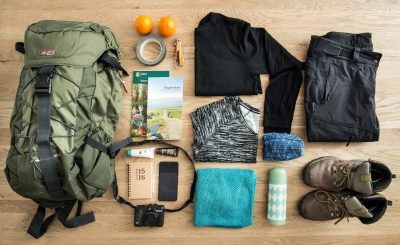35 items to bring on your pilgraimage if you plan to sleep in a tent
It is important to pack the right equipment for your pilgrimage in Norway, especially if you plan to sleep in a tent along the way. Here you’ll find a suggested packing list.

Experienced hikers know that it is important to pack light to have a comfortable hike. But it's also important to be prepared for changing weather. This also applies to a pilgrimage in Norway, especially if you plan to sleep outdoors in a tent for part or all of your trip.
Markus Holzmann chose to bring a tent, a sleeping bag and a primus on his pilgrim walk from Oslo to Trondheim. He started the preparations at home in Germany by reading up on the pilgrim paths in Norway.
The choice of equipment and test packing became an important part of the preparation. He thought thoroughly about what he needed to bring and found the lightest alternatives. He even went to the children’s department at IKEA to find a tiny spatula.
Markus’ backpack weighed 15 kg when he embarked from Oslo the 20th of June. He arrived at Nidaros Cathedral in Trondheim the 10th of June. He had then walked a total of 643 km, with an impressive average of 30 kilometers per day (the average pilgrim walks about 20 km per day).
– I just kept on walking until the evening came. Then I just found a nice place to pitch the tent. It was a great experience to sleep outside.
Markus slept in a tent most nights of his pilgrimage, and according to him, this is the reason he was able to walk such a long distances each day. Allthough you don't have to sleep in a tent on a pilgrimage through Norway (there are many nice accommodations along the way), for some, sleeping outdoors provides a greater experience.
Packing list for a pilgrimage with tent
- Backpack with suitable volume for your contents (typically 50–80 liters).
- Rain cover for the backpack.
- Waterproof packing bags.
- Lightweight tent.
- Lightweight sleeping bag (appropriate for expected temperatures).
- Lightweight sleeping mat.
- Hiking boots (good, sturdy ones) that are already broken in.
- Light shoes/sandals for use in the evenings.
- Waterproof jacket (alternatively a rain poncho).
- Waterproof pants.
- Lightweight windproof jacket.
- Hiking pants.
- Thermal long johns if you're crossing mountain areas.
- Two T-shirts and two long-sleeve shirts (wool or wool blend recommended).
- Warm mid-layer (sweater or jacket).
- Shorts (optional).
- 3 pairs of wool socks (two thin pairs, one medium-thick pair).
- Two sets of underwear.
- Swimwear.
- Cap/hat. If you're hiking in mountain areas, you must also bring mittens, a hat/beanie and a scarf.
- Small towel.
- Water bottle.
- Camping stove + lighter.
- Small cooking pot/frying pan + necessary cooking utensils.
- Eating utensils (spork/spoon, cup, plate).
- Pocketknife or multitool.
- Food supplies (for example freeze-dried meals, crispbread, oats, chocolate, etc).
- Toiletries in small containers (soap, toothbrush, foot/body/sunscreen, insect repellent, etc).
- Small first aid kit (sports tape, blister plasters, painkillers, etc).
- Toilet paper and trash bag (remember never to leave waste in nature).
- Map in a waterproof map case.
- Sunglasses.
- Mobile phone with charger and power bank.
- Some duct tape and cable ties (can fix almost anything).
- Pilgrim passport (not mandatory, but beneficial).
These items may also be useful
- Compass and/or GPS, especially if you’re crossing mountain areas. Some remote areas in Norway doesn't have mobile coverage.
- Guidebook. But keep in mind that information about accommodation, etc., may become outdated. You'll find updated info about accommodation options in the digital map.
- Small clothesline for use in the tent.
- A little detergent for laundry along the way.
- Trekking poles to reduce knee strain.
- Small headlamp or flashlight, especially if you're hiking late in the season.
- Emergency blanket (space blanket) for safety.

Tips
- Make sure your backpack fits you well, sits comfortably, and has padded shoulder straps and a hip belt.
- It's a good idea to leave behind heavy cameras and laptops to avoid an overly heavy pack.
- Your shoes must already be broken in when you start your pilgrimage.
- Choose clothing and equipment that are high quality and durable. The longer you use your gear, the better it is for the environment. Also, there is plenty of good second-hand hiking gear — you don’t always need to buy new.
- The average temperature in Norway in June-August is 14 degrees Celsius. It might reach up to 30 degrees on the warmest days, but it can also get quite cold, especially at night and in high altitudes.
- Read up on safety precautions on a pilgrimage through Norway.
Leave No Trace
- Avoid unnecessary packaging — use refillable bottles and containers.
- Always take all your trash with you.
- There is a general ban on campfires in Norway from 15th April to 15th September.
- Check your campsite thoroughly before leaving — you should leave no trace behind.

